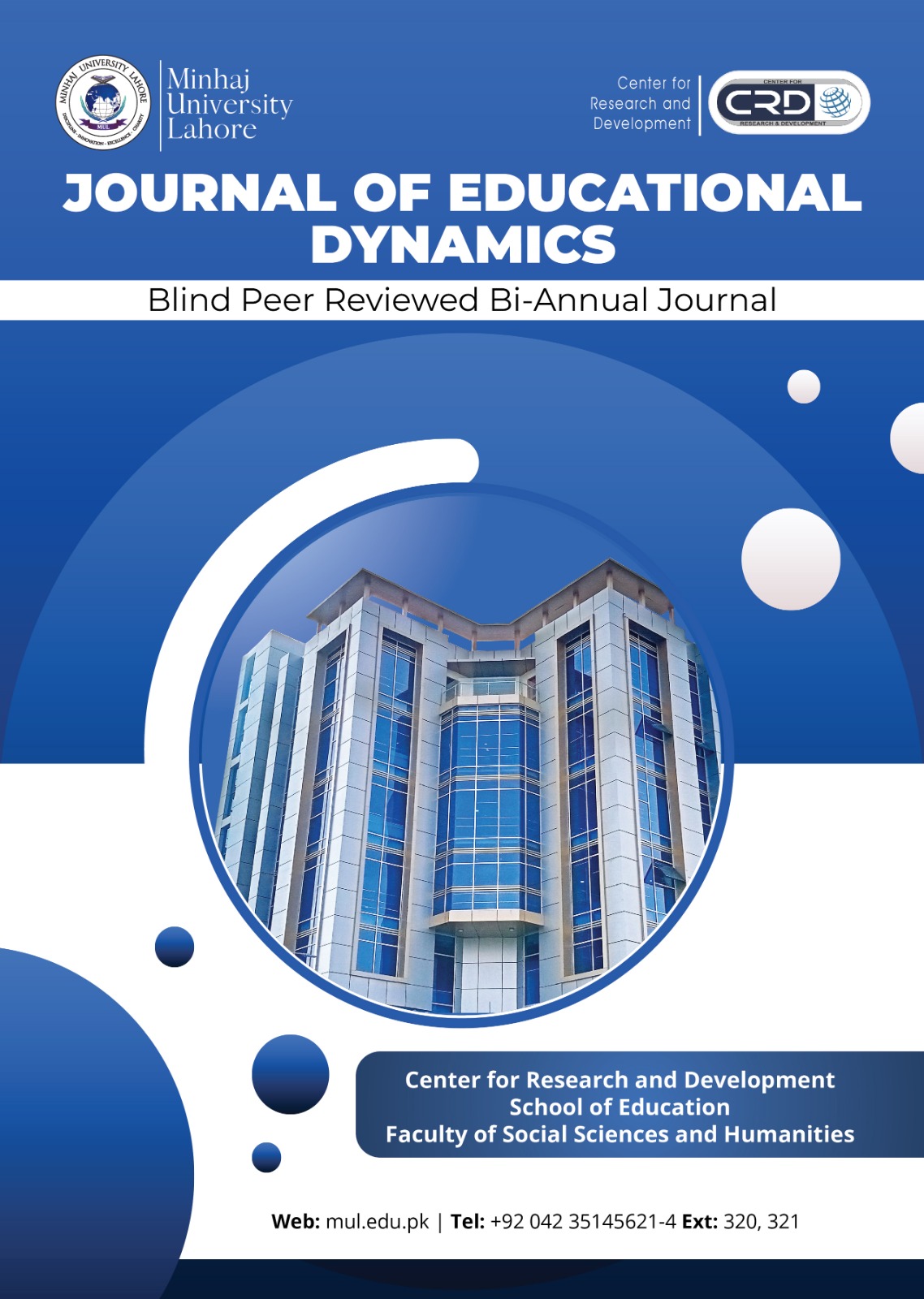Individual Peace in learning Process: A Narrative Study of Experiences
DOI:
https://doi.org/10.58932/MULI0014Keywords:
Individual peace, learning process, self-respect, respect for others, confident, experiencesAbstract
Education must be a procedure that influences the rate of individual peace to ensure that both teachers and students are feeling good during the teaching and learning process. Therefore, in order for learning to take place, teachers and students must communicate harmoniously. This study looks at the importance of personal tranquility in the educational process from the viewpoint of pupils at a public school in Narowal, Pakistan. In the present research, a narrative approach using a qualitative methodology was employed. Ten teachers and fifty-six pupils were randomly selected from a public school as participants of this study. Based on the experiences and narratives of the participants, which were documented by observation and interviews, data were qualitatively examined. The outcomes of the study designated that the existence of individual peace offers well-being and comfort for teachers and students in teaching learning process. The value of individual peace is the form of self-respect, respect for others, confidence, optimism, mindfulness and positive vision. In addition, a notable existence of such practices was found that did not reflect the individual peace, like self-hatred, uncooperative, violating the rules, unfair treatment, discrimination, not accepting differences. The recommendations of the study were developing a teaching module for individual peacebuilding and to supplement a program for individual peacebuilding for teachers as in-service and pre-service teacher trainings.
References
Aspers, P., & Corte, U. (2021). What is Qualitative in Research. Qualitative Sociology, 44(1), 599- 608.
Assegaf, A. R. (2000). Education without Violence [Pendidikan Tanpa Kekerasan]. Yogyakarta: Tiara Wacana.
Bano, A., Ali, S., & Iqbal, S. (2024). Individual peacebuilding in the elementary schools: Voices of Punjab, Pakistan. Pakistan Journal of Law, Analysis and Wisdom, 3(1), 37-42.
Barbey, C. (March,2018). Soft justice for all three levels of peace [Blog post]. à propos-Swisspeace.https://www.swisspeace.ch/apropos.
Berkowitz, M. W. (2011). What works in values education. International journal of educational research, 50(3), 153-158.
Bialen, V. B. (2025). Teachers’ motivations, challenges and difficulties in action research: A narrative study. Journal of Interdisciplinary Perspectives, 3(2), 1-1.
Castro, L. N., & Galace, J. N. (2019). Peace education: A pathway to a culture of peace (3rd edition). Quezon City: Center for Peace Education.
Chérif, L., Niemiec, R., & Wood, V. (2022). Character Strengths and Inner Peace. International Journal of Wellbeing, 12(3), 16-34.
Creswell, J. W., & Creswell, J. D. (2017). Research design: qualitative, quantitative and mixed methods approaches. Sage Publications.
Datu, J. A. D. (2017). Peace of mind, academic motivation, and academic achievement in Filipino high school students. The Spanish Journal of Psychology, 20(e20),1-8.
Faheem, J., & Iqbal, M. Z. (2021). Peace education: perceptions of secondary school teachers of province Punjab, Pakistan. Pakistan Social Sciences Review, 5(1), 1154-1164.
Galtung, J. (2018). Violence, peace and peace research. Organicom, 15(28), 33-56.
Junghare, I. Y. (2016). Colors of peace. Cultural and religious studies, 4(1), 14-27
Khan, N., Khalique, F., & Saini, K. (2025). Qualitative research methods: harnessing interviews, focus groups, observations, and document analysis. In Qualitative Research Methods in Air Transport Management (pp. 27-56). IGI Global Scientific Publishing.
Mazlumcu, E. (2021). The effect of inner peace on interpersonal peace and styles of
managing conflict. [Master's Thesis,,Marmara University,Turkey].Retrieved from search.proquest.com
Montano, R. L. T. (2023). Measurement of peace of mind and its influence on academic engagement among Filipino university students. Journal of Psychological and Educational Research, 31(1), 39-51.
Msila, V. (2024). Peace studies, knowledge and learner achievement. International
Journal of Educational Development in Africa,9(1),1-20.
Niyitunga, E. B. (2020). Peace Education. Administratio Publica, 28(4), 41-59.
Parmar, R. M. (2014). Role of teacher for peace education. The International Journal of Indian Psychology, 2(2), 1-8.
Polat, S., Arslan, Y., & Günçavdi, G. (2016). The qualities of teachers who instruct peace education: Views of prospective teachers' who attended the peace education programme. Journal of Education and Practice, 7(28), 36-45.
Polkinghorne, D. E. (1995). Narrative configuration in qualitative analysis. International Journal Qualitative Studies in Education, 8(1), 5-23.
Priya, P. (2022). Practical issues for conducting qualitative research. Journal of NELTA, 27(1-2), 213-215.
Santoso, M. A. F., & Khisbiyah, Y. (2021). Islam-based peace education: values, program, reflection and implication. Indonesian Journal of Islam and Muslim Societies, 11(1), 185-207.
Setiadi, R. (2020, February). Peace education pedagogy: a strategy to build peaceful schooling. In International Conference on Educational Psychology and Pedagogy-" Diversity in Education"(ICEPP 2019) (pp. 161-166). Atlantis Press.
Shahmohammadi, N. (2014). Review on the impact of teachers’ behaviour on students’ self-regulation. Procedia-Social and Behavioral Sciences, 114(1), 130-135.
Umar, M., Hakam, K. A., & Somad, M. A. (2019). Peace values in learning process (Adescriptive study based on student experiences). Advances in Social Science, Education and Humanities Research, 253(1), 20-23.
Xi, J., & Lee, M. T. (2021). Inner peace as a contribution to human flourishing: A new scale developed from ancient wisdom. In
M. T. Lee, L. D. Kubzansky, & T. J. VanderWeele (Eds.), Measuring well-being: Interdisciplinary perspectives from the social sciences and the humanities (pp. 435–481). Oxford University Press.








